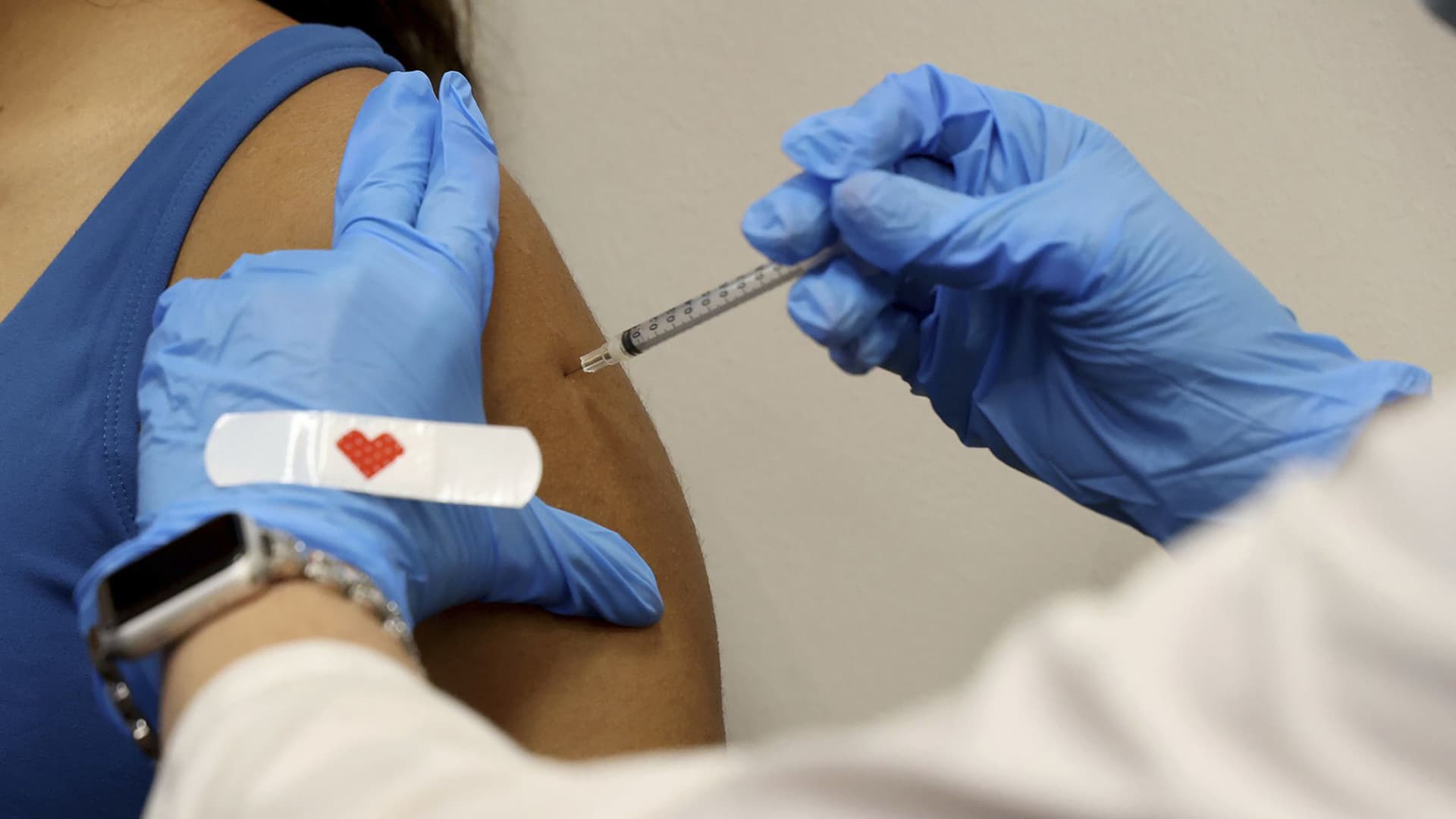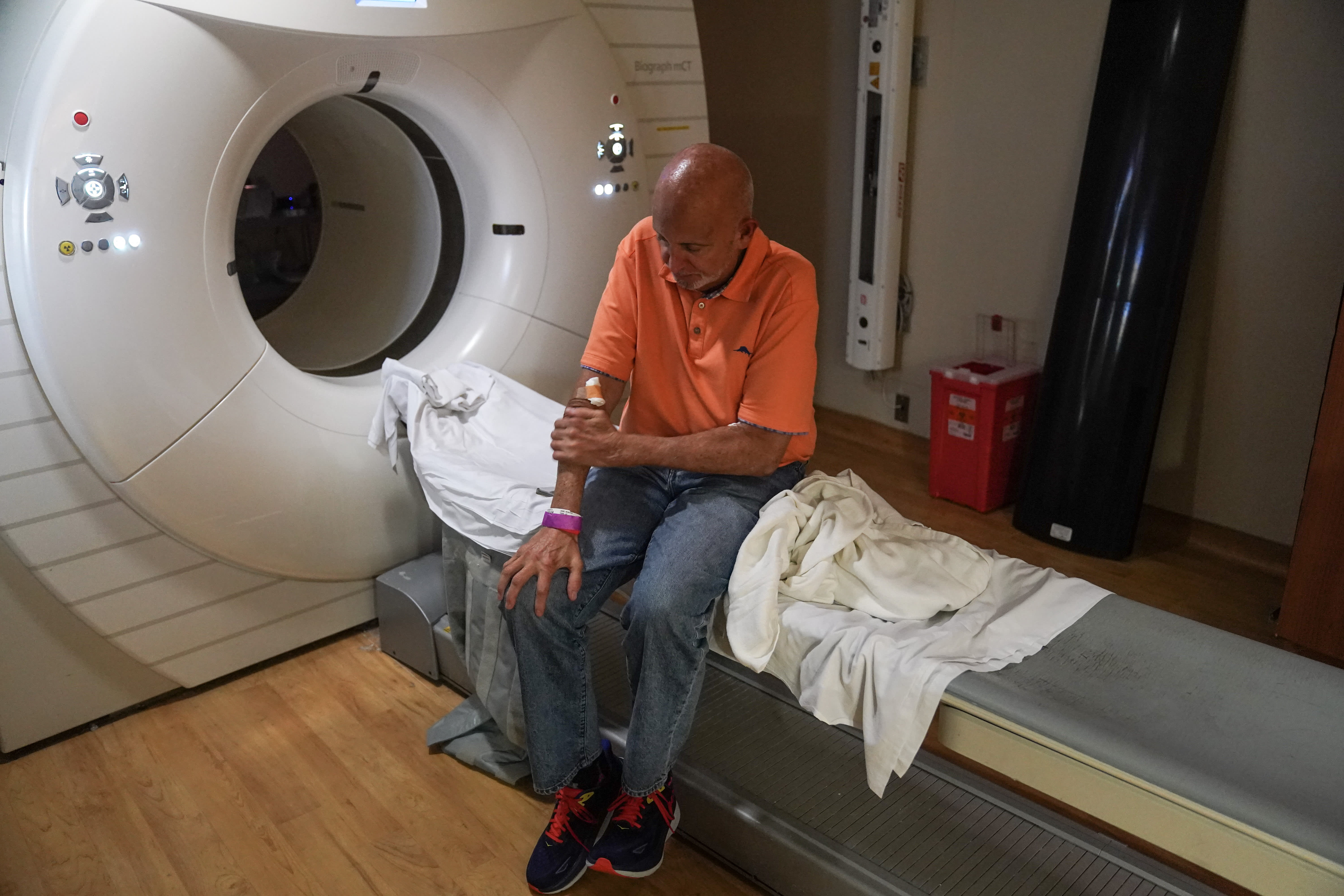
A pharmacist delivers a COVID-19 booster dose at a Chicago CVS store.
Antonio Perez | Tribune News Service | Getty Images
A new round of Covid vaccines is coming to the U.S. this fall — but many Americans may not roll up their sleeves and take one.
That’s largely because pandemic fatigue, the belief that Covid is “over” and confusion over personal risk levels could deter some people from getting an additional shot, experts in public health and health policy told CNBC.
But they said public health officials and health-care providers could potentially increase uptake of the new vaccines by communicating a new and simple message this fall: Covid vaccines are likely going to become a routine part of protecting your health moving forward.
In September, vaccine manufacturers Pfizer, Moderna and Novavax are slated to deliver new single-strain Covid shots targeting the omicron subvariant XBB.1.5, the most immune-evasive strain of the virus to date.
It will be a “very uphill battle” to get people to take those jabs, especially given the sluggish uptake of the most recent shots that rolled out, said Jen Kates, senior vice president of the health policy research organization KFF.
Only about 17% of the U.S. population — around 56 million people — have received Pfizer and Moderna’s bivalent Covid vaccines since they were approved last September, according to the Centers for Disease Control and Prevention. Bivalent means they target two strains of the virus.
Less than half of adults 65 and older have received a bivalent shot, while rates for all other age groups sit at around 20%.
Pfizer, Moderna and Novavax have not provided exact estimates for what they expect uptake of their new shots to look like.
But a Pfizer spokesperson said overall the company expects 24% of the population, or 79 million people, to receive vaccine doses in 2023, which includes both primary doses and boosters. A Novavax spokesperson said the company has started “manufacturing at risk” and is “stockpiling enough material to support the upcoming launch for the season.”
All companies have noted that they are preparing for the federal government to shift vaccine distribution to the private market, meaning manufacturers will sell their updated shots directly to health-care providers at higher prices. Previously, the government purchased vaccines directly from manufacturers at a discount to distribute to the public for free.
Regardless of that shift, experts say vaccine uptake may not look much different from that of the bivalent boosters. Here’s why.
Pandemic fatigue, confusion
Fatigue over the pandemic and the general belief that Covid is “over” could potentially hinder the uptake of new shots this fall, experts said.
A June poll conducted by Gallup found that 64% of Americans think the pandemic is over in the U.S. and only 18% are worried about contracting the virus.
Ipsos and Axios released a survey with similar findings in May, the same month the U.S. ended the national Covid public health emergency amid a downward trend in cases, hospitalizations and deaths.
But Covid is still killing people every day and isn’t going away anytime soon. Meanwhile, many Americans are becoming weary of recommendations for protection. That includes masking, testing for the virus and getting vaccinated.
“People have essentially moved on, especially given how long the pandemic has been,” Dr. Kartik Cherabuddi, a professor of medicine at the University of Florida, told CNBC.
He said that’s why it’s important to stress how people will personally benefit from receiving an additional vaccine this fall.
But there’s an even a bigger problem: Personal Covid risks and benefits from getting another shot have been a major area of confusion for Americans, which could also hamper the uptake.
The confusion stems from the fact that “risk levels aren’t the same for everybody in the population right now,” and almost everyone has a different circumstance, according to Dr. Brad Pollock, chair of UC Davis Health’s department of public health sciences.
“It’s this perception of the individual. ‘Why should I get another booster? What is my risk? Why should I do it? Is it really worth doing now, or later?'” Pollock told CNBC. “I think everybody’s confused. And when they’re confused, they probably will do nothing until there’s more clarity.”
Safeway pharmacist Ashley McGee fills a syringe with the Pfizer COVID-19 booster vaccination at a vaccination booster shot clinic on October 01, 2021 in San Rafael, California.
Justin Sullivan | Getty Images
The CDC hasn’t recommended the updated shots to specific groups yet because they haven’t been approved by the Food and Drug Administration. But even after eligibility guidelines are formalized, confusion could potentially remain.
Those at high risk of severe Covid, such as older adults and immunocompromised people, could potentially benefit more than the general population.
But even those patients have different circumstances: Some high-risk people may have recently received a fifth vaccine dose, which could push back when they can get the updated vaccine. Health officials usually recommend spacing out vaccinations over a specific number of months.
Meanwhile, some healthy adults may have four doses but may be unsure about getting another because the benefit of a fifth dose for those less vulnerable to severe Covid still isn’t clear, Pollock said.
People who recently had Covid may also have to wait longer to get a new shot so they can maximize the protection they get from vaccination — a recommendation made when the bivalent boosters rolled out.
But that could get even more complicated this fall, according to Cherabuddi. He said testing for Covid has dropped to new lows over the past year, “so we don’t even know who has been infected in the last few months.”
Those individualized circumstances will likely make it more challenging for both health officials and health-care providers to convey clear messages about the updated vaccines this fall, Cherabuddi and other experts said.
The Health and Human Services Department did not immediately respond to CNBC’s request for comment.
Vaccine manufacturers have noted that they will continue to engage in a variety of outreach efforts to encourage the public to get vaccinated.
A new message may increase rates
But KFF’s Kates said health officials and providers could potentially increase uptake if they communicate that Covid shots are “likely going to be more of a routine part of our health care going forward.”
The FDA and CDC are hoping to transition toward a flu shot-like model for Covid vaccines, meaning people will get a single jab every year that is updated annually to target the latest variant expected to circulate in the fall and winter.
A man walks past an urgent care facility offering flu shots in New York, the United States, on Dec. 7, 2022.
Michael Nagle | Xinhua News Agency | Getty Images
Kates said that schedule aims to simplify the process of getting vaccinated. For example, it will likely make it easier for Americans to remember to get a new vaccine every year and allow them to receive one with their flu shot during the same doctor’s visit.
“People might be more open to making this a normal part of what they do,” Kates said. “That contrasts with what we’ve seen in the past where there are different vaccines, different timing, different age groups and something new to consider every few months.”
There’s still uncertainty about whether the U.S. will update and distribute new shots on an annual basis, according to Kates.
Advisors to the FDA have raised concerns about shifting to yearly Covid vaccines, noting that it’s unclear if the virus is seasonal like the flu.
A KFF poll released in April suggests that an annual schedule may boost uptake: More than half of the public said they would likely get an annual Covid shot if it was offered like an annual flu shot. That includes about a third who would be “very likely” to do so.
Pfizer similarly told CNBC in May that an annual Covid schedule could encourage more people to vaccinate each year. The company is preparing to shift to that schedule by developing “next-generation” versions of its shot, which aim to extend the protection people get from the virus to a full year.
Commercial market may not change much
It’s unclear whether the U.S.’s shift to the commercial market will affect the uptake of the new vaccines.
It may not change much for insured Americans. Private insurers and the government-run Medicare and Medicaid programs are required to cover all shots recommended by the CDC, meaning most of the insured will continue to get Covid shots for free.
Federal and corporate programs are aiming to fill the gap for the 25 million to 30 million uninsured adults in the U.S. That includes the Biden administration’s Bridge Access Program, which plans to provide free Covid vaccines to uninsured people through 2024.
Kates said it’s “still hard to gauge” how many uninsured people will benefit from those efforts.
She also noted that a shift in access could potentially lower uptake among the group. “Somebody might be worried that they won’t get their vaccine covered or they’ll be asked to pay for it when they can’t afford it. That could be a big deterrent,” Kates said.
But Dr. Helen Chu, an epidemiology professor at the University of Washington School of Medicine, said the uninsured have continued to lag behind their insured counterparts in terms of vaccine uptake even “when shots were freely available to them.”
A KFF survey conducted in March found that only 22% of uninsured Americans under 65 were both vaccinated and boosted against Covid, compared with 44% of insured people in that age group. Another KFF survey from mid-2021 showed similar findings.
“I’m not sure that a person’s insurance status was necessarily the driver of the low uptake we’ve seen, or whether it will be the driver of potentially low uptake in the fall as well,” Chu told CNBC.


